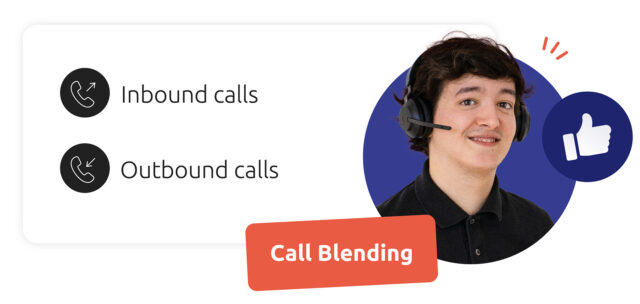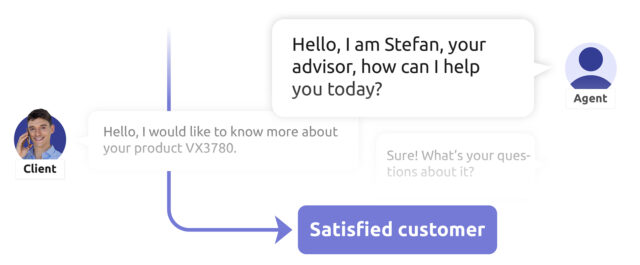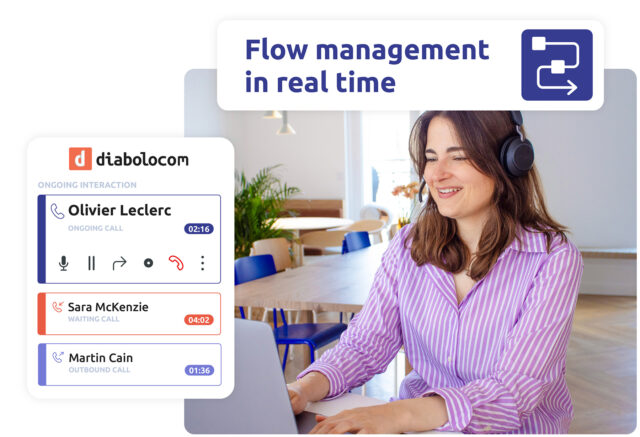Call Blending
Call blending is an ideal solution for contact centers handling both inbound and outbound calls. Find out how this approach maximizes agent productivity while enhancing the customer experience.
What is call blending?
Call blending is a call management method that combines inbound and outbound calls in a call center. This technique maximizes agent productivity by ensuring that they are always busy. It also prioritizes the voice channel, which is particularly appreciated by customers.

Advantages of call blending
Improved agent productivity
Call blending reduces downtime by ensuring that an agent always has a call to handle. By automating tasks, agents can concentrate on the calls assigned to them, without having to search for contacts and dial numbers manually. Call blending thus improves agent productivity by maximizing the number of interactions they handle on a daily basis.

Balance of activity between agents
Call blending assigns incoming calls to agents when they’re not handling outgoing calls, ensuring a balanced workload. This allows agents to engage in diverse tasks like teleprospecting and customer loyalty, while also adopting a proactive approach to customer satisfaction by addressing needs promptly.

Relying on conversational communication for greater customer satisfaction
Voice remains the most powerful channel for customer relations, but it demands significant human resources. Call blending optimizes the distribution of call volume among agents, ensuring that their time is used efficiently for customer interactions. This strategy fosters a continuous dialogue with customers, enhancing both satisfaction and loyalty.

Challenges of call blending
Initial configuration complexity
Call blending requires precise configuration to fit your organization and route calls to the right people. If you want to adopt this approach, rely on advanced call center software, which will support you every step of the way in setting up call blending, as well as monitoring performance.
Need for multi-skilled agents
Managing inbound and outbound calls requires different skills. To set up call blending, you need to rely on agents who know how to handle a variety of subjects: customer service, sales prospecting, customer loyalty… It is therefore advisable to start by allocating these calls to the most experienced agents, and to train those who need it.
Using call blending
How do I use call blending?
To use call blending, you need a telephony system that handles both incoming and outgoing calls. You need to check whether the solution offers a call blending system with advanced functionalities. This includes real-time management of incoming and outgoing flows, based on criteria such as the skills and availability of each agent.
Diabolocom’s call center software integrates an advanced call blending system to help you set up mixed call management in your call center.

FAQ
What are the advantages of call blending for call centers?
Call blending optimizes the management of inbound and outbound calls in a mixed call center, offering the following advantages:
- Improved agent productivity: agents are always busy with incoming and outgoing calls.
- Balance of activity: thanks to call blending, companies can maintain a balance between different activities such as customer service, teleprospecting and promotion, optimizing call center ROI.
Improved customer experience: in the event of peaks in incoming calls, call blending enables all agents to be mobilized to answer calls and reduce waiting time for customers.
Is call blending suitable for all types of call center?
Call blending is ideal for mixed call centers, i.e. those handling both outbound and inbound calls. Call blending enables mixed call management, by automating the allocation of calls to agents.
Other types of call centers can turn to other functionalities. In outbound call centers, the power dialer optimizes call management. In inbound call centers, the automatic call distributor (ACD) improves routing of customer-initiated calls.
How does call blending improve customer satisfaction?
By managing both inbound and outbound calls, call blending contributes to greater customer satisfaction in several ways:
- Efficient follow-up of requests: call blending helps to ensure better follow-up between each incoming or outgoing call. The customer speaks to an agent who is already familiar with his or her case, or who has access to all the necessary information on his or her request.
- Improved quality of service: multi-skilled agents help to handle requests more efficiently, and reduce redirections between several contacts.
Reduced waiting times: mixed call management minimizes customer waiting times, especially during peaks in incoming calls.
What skills do call blending agents need?
In a call center based on call blending, agents handle both inbound and outbound calls. They therefore need to be versatile enough to handle a variety of activities, including customer service, telemarketing and loyalty actions. To help them switch between different types of call, companies can rely on a telephony system that centralizes contextual information on each customer.